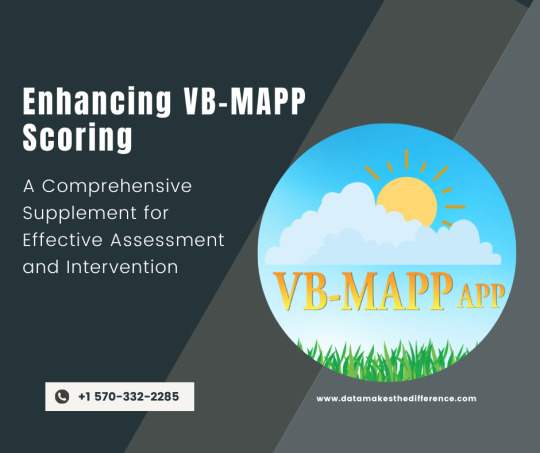#ASDsupport
Explore tagged Tumblr posts
Text
Breaking Down VB-MAPP Evaluation: What are the Common Barriers and Solutions?
When it comes to assessing and understanding the skills and abilities of individuals with autism, the VB-MAPP (Verbal Behavior Milestones Assessment and Placement Program) is a widely used tool. However, like any assessment, it comes with its own set of challenges. In this blog post, we will delve into the common barriers faced during VB-MAPP evaluations and explore potential solutions to enhance the assessment process.

Understanding VB-MAPP:
Before we discuss the barriers, let's briefly understand what VB-MAPP is and why it is crucial in the field of autism intervention. Developed by Dr. Mark L. Sundberg, VB-MAPP is designed to assess and track the language and social skills of individuals with autism spectrum disorder (ASD). It consists of a set of 170 milestones grouped into various skill areas, providing a comprehensive overview of a person's abilities and areas that may need intervention.
Common Barriers in VB-MAPP Evaluation:
Limited Engagement: One significant barrier encountered during VB-MAPP evaluations is the limited engagement of the individual being assessed. Individuals with autism often face challenges in focusing, which can hinder the accurate observation of their skills. This limitation may result in incomplete data and an inaccurate representation of their true abilities.
Communication Challenges: Since VB-MAPP focuses heavily on language and communication skills, individuals with limited verbal abilities may struggle to demonstrate their true potential. Non-verbal individuals, in particular, may find it challenging to express their capabilities through traditional assessment methods, impacting the accuracy of the evaluation.
Sensory Sensitivities: Sensory sensitivities are prevalent among individuals with autism, and these sensitivities can interfere with the assessment process. For instance, an individual may become overwhelmed by environmental stimuli during the evaluation, leading to atypical behaviors that do not accurately reflect their typical functioning.
Solutions to Overcome Barriers:
Enhancing Engagement Strategies: To address limited engagement, incorporating personalized and motivating strategies is essential. Tailoring the assessment environment to suit the individual's preferences and interests can increase their engagement. Additionally, introducing short breaks or incorporating sensory-friendly elements can contribute to a more comfortable and engaging evaluation experience.
Alternative Communication Methods: For those with limited verbal abilities, adopting alternative communication methods is crucial. Augmentative and alternative communication (AAC) tools, such as picture-based systems or assistive technology devices, can provide individuals with alternative ways to express themselves. This ensures a more accurate representation of their communication skills.
Sensory-Friendly Assessment Environments: To accommodate sensory sensitivities, creating a sensory-friendly assessment environment is vital. This may include adjusting lighting, minimizing auditory distractions, and providing sensory tools or breaks as needed. A comfortable and accommodating environment can help individuals with autism feel more at ease during the evaluation, leading to more accurate results.
Conclusion:
In the world of autism intervention, the VB-MAPP assessment plays a crucial role in understanding and addressing the unique needs of individuals with autism spectrum disorder. However, recognizing and overcoming common barriers is essential for ensuring the accuracy and reliability of the assessment process. By implementing personalized strategies to enhance engagement, incorporating alternative communication methods, and creating sensory-friendly environments, we can strive to make VB-MAPP evaluations more effective and meaningful for individuals with autism. In breaking down these barriers, we pave the way for a more accurate understanding of their abilities and a more targeted approach to intervention and support.
#VBMAPP#AutismAssessment#ABAtherapy#SpecialEducation#CommunicationSkills#SensoryFriendly#InclusiveIntervention#ASDsupport#BarriersInAssessment#EmpowerAutism
0 notes
Text
Navigating Social Skills in Children with Autism
Unlock the potential of social skills in children with autism with our expert guide! Perfect for parents and educators seeking meaningful progress. #AutismAwareness #SocialSkills #ParentingTips #ASDSupport
Navigating the social world can be complex and challenging, particularly for children with autism spectrum disorder (ASD). They often face unique challenges that can make everyday social interactions more difficult. This article aims to shed light on these challenges and offer practical strategies to help them develop essential social skills. Understanding Autism and Social Skills Autism is a…

View On WordPress
0 notes
Text
Enhancing VB-MAPP Scoring: A Comprehensive Supplement for Effective Assessment and Intervention
The VB-MAPP (Verbal Behavior Milestones Assessment and Placement Program) is a widely-used tool in the field of applied behavior analysis (ABA) for assessing and treating language and communication skills in individuals with autism spectrum disorder (ASD). To further optimize the utilization of VB-MAPP, a groundbreaking scoring supplement has been developed, promising a more nuanced and effective approach to assessment and intervention.

This comprehensive VB-MAPP scoring supplement is designed to address the evolving needs of professionals working with individuals with ASD, ensuring a more accurate and tailored understanding of their verbal behavior milestones. With a focus on refining the assessment process and streamlining intervention strategies, this supplement aims to elevate the impact of the VB-MAPP in fostering language development and communication skills.
The scoring supplement introduces innovative tools and methodologies to enhance the precision of VB-MAPP assessments. It provides additional criteria and benchmarks for each milestone, allowing practitioners to capture a more nuanced picture of the individual's language abilities. This supplement takes into account the diverse range of communication styles and abilities within the ASD population, ensuring a more inclusive and representative assessment process.
One key feature of the VB-MAPP scoring supplement is its incorporation of the latest research findings and evidence-based practices in the field of ABA. By integrating cutting-edge knowledge, the supplement aims to stay ahead of the curve and provide professionals with the most up-to-date and effective tools for assessing and addressing language and communication challenges in individuals with ASD.
The scoring supplement also includes a user-friendly guide that assists practitioners in interpreting the results and making informed decisions about intervention strategies. This guide serves as a valuable resource for both seasoned ABA professionals and those new to the field, offering insights into how to leverage the information gathered from the VB-MAPP assessment to develop targeted and individualized intervention plans.
Furthermore, the VB-MAPP scoring supplement emphasizes collaboration and communication among interdisciplinary teams. By providing a standardized framework for assessing language milestones, it facilitates more seamless communication among professionals, ensuring a cohesive and coordinated approach to intervention.
In conclusion, the VB-MAPP scoring supplement represents a significant advancement in the field of ABA, offering professionals a sophisticated and comprehensive tool to enhance the accuracy and effectiveness of their assessments and interventions. With its focus on inclusivity, evidence-based practices, and user-friendly guidance, this supplement is poised to become an invaluable resource for practitioners dedicated to supporting the language and communication development of individuals with ASD.
#VBMAPP#ABA#AutismAssessment#CommunicationSkills#EvidenceBasedIntervention#LanguageDevelopment#ASDsupport#BehaviorAnalysis#InclusiveAssessment#SpecialEducationTools
0 notes
Text
Decoding Development: Unveiling the Significance of EESA Assessment
In the ever-evolving landscape of autism intervention, understanding and addressing the unique communication challenges faced by individuals with autism spectrum disorder (ASD) is of paramount importance. One instrumental tool in this endeavor is the Early Echoic Skills Assessment (EESA). This article aims to decode the significance of the EESA assessment, shedding light on its role in unraveling the intricacies of early vocal imitation skills and fostering development in individuals with ASD.

Understanding the Foundation: Early Vocal Imitation Skills
Before delving into the significance of EESA, it's crucial to recognize the foundational role of early vocal imitation skills in language development. For individuals with ASD, who may face challenges in social communication, developing the ability to vocally imitate sounds, words, and phrases is a critical milestone. Early vocal imitation lays the groundwork for expressive language, social interaction, and overall communication proficiency.
EESA Assessment: A Comprehensive Approach
The EESA assessment is specifically designed to evaluate and enhance early vocal imitation skills in individuals with ASD. Developed within the framework of applied behavior analysis (ABA), EESA goes beyond traditional assessments by providing a comprehensive and systematic approach to understanding an individual's current abilities and challenges in the realm of vocal imitation.
1. Identifying Developmental Milestones:
The EESA assessment breaks down the complex process of vocal imitation into distinct developmental milestones. By categorizing these milestones, ranging from basic vocalization to more advanced imitation of words and phrases, the assessment provides a roadmap for understanding where an individual lies on the spectrum of vocal imitation skills.
2. Tailoring Interventions to Individual Needs:
One of the key advantages of the EESA assessment is its ability to inform personalized interventions. By identifying specific strengths and areas that may need additional support, caregivers, educators, and therapists can tailor interventions to suit the unique needs of each individual. This tailored approach increases the likelihood of success in fostering early vocal imitation skills.
3. Tracking Progress Over Time:
Progress in communication development is not always linear, and the EESA assessment recognizes this by providing a tool for tracking changes and improvements over time. Regular assessments allow for the measurement of progress, adjustment of interventions, and celebration of achievements, fostering a dynamic and responsive approach to individual needs.
Significance of EESA in Early Intervention:
1. Early Identification of Communication Barriers:
EESA plays a pivotal role in early identification of communication barriers. By pinpointing specific challenges in vocal imitation, such as difficulties in echoing sounds or imitating words, the assessment equips caregivers and educators with valuable insights. Early identification sets the stage for targeted interventions, addressing communication barriers before they become entrenched.
2. Foundation for Language Development:
Language development is a multifaceted process, and early vocal imitation skills form a crucial foundation. EESA, by assessing and enhancing these skills, contributes to the scaffolding necessary for the development of expressive language. This, in turn, opens pathways for improved social communication and interaction.
3. Individualized Support Strategies:
Each individual with ASD is unique, and the significance of EESA lies in its ability to inform individualized support strategies. Whether it's providing additional prompts, incorporating visual supports, or adapting the environment to encourage vocalization, EESA empowers caregivers and educators to implement targeted strategies tailored to the specific needs of each individual.
Challenges and Considerations:
While recognizing the significance of EESA, it's essential to acknowledge potential challenges and considerations in its implementation. Factors such as individual variability, environmental influences, and the need for ongoing assessment highlight the dynamic nature of communication development. EESA is not a one-size-fits-all solution but rather a dynamic tool that requires continuous evaluation and adaptation.
Conclusion: Empowering Development Through EESA Assessment
In conclusion, the significance of the EESA assessment lies in its capacity to decode the complexities of early vocal imitation skills in individuals with ASD. By identifying developmental milestones, tailoring interventions, and tracking progress over time, EESA becomes a powerful ally in the journey of early intervention. It empowers caregivers, educators, and professionals to navigate the intricate path of communication development, unlocking the potential for meaningful progress and enhanced quality of life for individuals with ASD.
Decoding development through EESA is not just a process; it is an ongoing commitment to understanding, supporting, and celebrating the unique journey of each individual. As we unveil the significance of the EESA assessment, we pave the way for a future where communication barriers are dismantled, and the echoes of progress resound through the lives of those with autism, fostering connection, understanding, and the realization of their full potential.
#EESAassessment#AutismCommunication#EarlyIntervention#SpeechDevelopment#ASDsupport#CommunicationMilestones#SpecialEducation#DecodingDevelopment#EmpoweringASD#UniqueVoices
1 note
·
View note